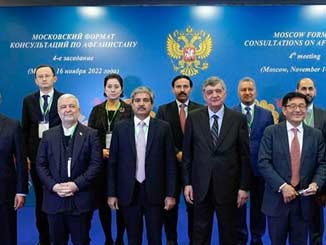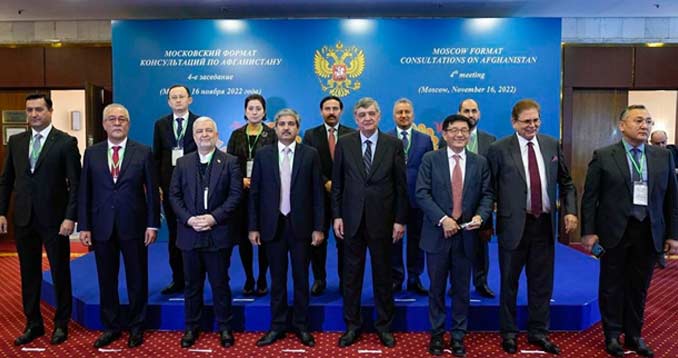

Hasht-E-Subh Regionalism/regional convergence is seen as one of the most cost–effective and expedient methods of achieving collective political security, stability, and economic development for countries located in a particular geographical area. When looking back at the historical crises and conflicts of countries in Central Asia, the Middle East, South and Southeast Asia, and the West Bank of the Jordan River and Africa, it is evident that these crises have been reduced. This has been achieved through the formation of a regional consensus centered around the countries affected by the crises.
Due to its location at the junction of two highly strategic regions of Asia (Central Asia and South Asia), Afghanistan is of great geopolitical and geostrategic importance. It is situated on the Silk Highway close to China‘s Belt and Road Initiative (BRI), in the strategic energy region of the world, and at the center of four security complexes (the South Asian security complex centered on the two nuclear powers of India and Pakistan, Central Asia centered on Russia and the five republics of this region, the Far East centered on nuclear China and industrialized Japan, and the Middle East centered on powers such as Iran, Saudi Arabia, Turkey, and Israel). This advantageous position in the security strategies, geo–economics, and culture among regional actors has attracted the interest of every actor, allowing each to define strategic depth for themselves.
A large part of the current crisis in Afghanistan can be traced back to external variables and fertilizers. In addition to the internal and independent variables, such as failed nation–building, concentration of power, foreign policy crisis, and the war of tradition and modernity, external variables, such as the intervention of countries in the region, are considered to be the second cause of political instability, crisis, and continuous conflict. Consequently, instability in Afghanistan affects the stability of the entire region, and stability in Afghanistan is necessary for the stability and security of all countries in the region. In the crisis of the last half–century, particularly the collapse of August 15, 2021, followed by the emergence of the Taliban, some actors in the region and neighboring Afghanistan (Pakistan, Qatar, Iran, and Russia) have played a prominent role. Nearly 20 months have passed since the collapse of the republic in Afghanistan and the new regime has been managing the country in its own way. Extremist groups from all over the countries in the region have gathered in this country and are carrying out operations, leading to the most difficult, dark, unprecedented, and terrifying scenarios for the current and future stability and security of the region.
The national security and even the political survival of Pakistan, as a strategic supporter of the Taliban after their re–emergence in Afghanistan and the rise of the Tehreek–e Taliban Pakistan (TTP), is facing a threat. Recently, some of the most devastating attacks have been carried out in Pakistan, such as the attack on the Nizamiye Masjid in Peshawar, several military bases in Khyber Pakhtunkhwa, and the most recent suicide attack on the police headquarters, resulting in hundreds of casualties. Furthermore, the recent unrest and disobedience in North Waziristan has caused Pakistani officials and the generals of the intelligence apparatus, who are the final decision–makers, to lose sleep as they search for a way out of the predicament they have created.
Iran, the western neighbor of Afghanistan, has been facing a great danger recently. The borders between the two countries have become highly vulnerable and critical. Since August 15, 2021, there have been several terrorist attacks targeting the shrine of Imam Reza in Mashhad and a mosque in Shiraz. Additionally, the provinces of Sistan and Baluchistan, which are already highly volatile and vulnerable, have experienced further unrest and casualties.
Following the collapse of the republic in Afghanistan, the security and stability of Russia and the five Central Asian republics have been threatened more than ever. According to the latest report from Sputnik news agency, between 4,500 and 6,000 fighters from terrorist groups, the majority of whom are members of the Daesh branch of Khorasan, Ansarullah, Jundallah, Tehreek–e Taliban of Uzbekistan and Islamic Movement of Tajikistan, are lined up at the border of the Amu Darya, provinces of Badakhshan, Takhar, Kunduz, and Balkh. The magnitude of these concerns is such that it has become a threat to the collective security agreement. A few days ago, the secretary of this pact warned that in the event of any action by Afghanistan, this pact would respond with a massive military attack within 12 hours.
In the interim, China and India have not profited from Afghanistan‘s increasing instability and crisis. Reports indicate that hundreds of Uyghurs, members of the East Turkestan Islamic Movement (ETIM) in the provinces of Badakhshan and Takhar, Afghanistan, are currently attempting to reach China. Additionally, Indian media, citing the Secretary of the Security Council of India, have reported that Kashmiri separatist forces fighting for independence from India have acquired weapons and light equipment left behind by NATO forces in Afghanistan, which has exacerbated India‘s worries.
The security and political challenges that have arisen, as well as the uncertain future of Afghanistan, pose a threat to the interests of all regional actors, including Russia, Pakistan, Iran, India, and China, which are all distant neighbors of Afghanistan and have a significant role in this situation.
It has been 20 months since the US withdrew from Afghanistan on August 15, leading to the collapse of the country and the return of the Taliban to power. Despite this, no country, not even the most ardent supporter of the Taliban, is willing to recognize them. This demonstrates that the countries of the region have a full understanding of the severity of the Afghan crisis and its potential ramifications, and are attempting to find a way to address the security and political emergency in Afghanistan.
An investigation has revealed that over the past twenty months, eight regional meetings and discussions have been held in cooperation with countries involved in the Afghanistan crisis. Of particular importance were the annual meetings of the Shanghai Cooperation Organization, the Collective Security Treaty Organization, the Moscow Format, the Dushanbe Security Meeting, and the unofficial negotiations in Tehran between the Taliban and the National Resistance Front. These meetings have all highlighted the need for the formation of a comprehensive and legal government in Afghanistan, indicating a regional consensus among the countries involved in the crisis and instability of Afghanistan, which is seen as a positive step towards bringing stability to the region and preventing the spread of the Afghanistan’s crisis. Another cause for optimism is Russia‘s emphasis on the establishment of the G5 coalition, a framework for the coordination of regional powers such as Russia, China, Iran, Pakistan, and India, to achieve a local solution to Afghanistan’s conflict. It is essential to understand that if the regional players are sincere in their efforts to bring stability to Afghanistan, there is hope for the future and a clear vision. If the situation in Afghanistan persists and the neighboring countries continue to fuel the fire, leaving Afghanistan to its own devices, a transformation will occur in the region that will destroy many systems.

Leave a Reply